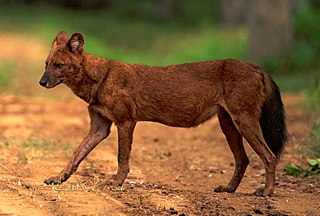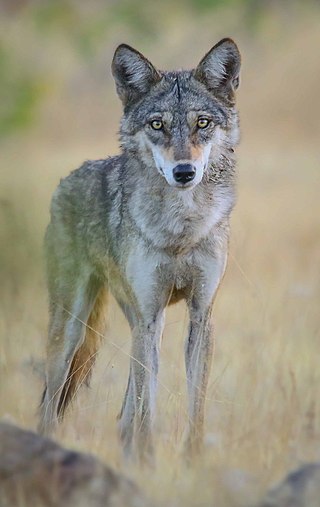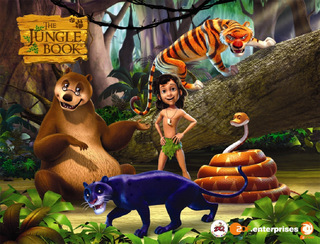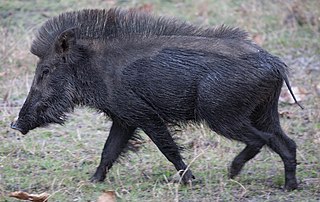
The dhole is a canid native to Central, South, East and Southeast Asia. Other English names for the species include Asian wild dog, Asiatic wild dog, Indian wild dog, whistling dog, red dog, red wolf, and mountain wolf. It is genetically close to species within the genus Canis, but distinct in several anatomical aspects: its skull is convex rather than concave in profile, it lacks a third lower molar and the upper molars sport only a single cusp as opposed to between two and four. During the Pleistocene, the dhole ranged throughout Asia, Europe and North America but became restricted to its historical range 12,000–18,000 years ago.

Jackals are medium-sized canids native to Africa and Eurasia. While the word "jackal" has historically been used for many canines of the subtribe canina, in modern use it most commonly refers to three species: the closely related black-backed jackal and side-striped jackal of sub-Saharan Africa, and the golden jackal of south-central Europe and Asia. The African golden wolf was also formerly considered as a jackal.

The Jungle Book (1894) is a collection of stories by the English author Rudyard Kipling. Most of the characters are animals such as Shere Khan the tiger and Baloo the bear, though a principal character is the boy or "man-cub" Mowgli, who is raised in the jungle by wolves. The stories are set in a forest in India; one place mentioned repeatedly is "Seeonee" (Seoni), in the central state of Madhya Pradesh.

The Second Jungle Book is a sequel to The Jungle Book by Rudyard Kipling. First published in 1895, it features five stories about Mowgli and three unrelated stories, all but one set in India, most of which Kipling wrote while living in Vermont. All of the stories were previously published in magazines in 1894–5, often under different titles. The 1994 film The Jungle Book used it as a source.

Baloo is a main fictional character featured in Rudyard Kipling's The Jungle Book from 1894 and The Second Jungle Book from 1895. Baloo, a sloth bear, is the strict teacher of the cubs of the Seeonee wolf pack. His most challenging pupil is the "man-cub" Mowgli. Baloo and Bagheera, a panther, save Mowgli from Shere Khan the tiger, and endeavor to teach Mowgli the Law of the Jungle in many of The Jungle Book stories.

Shere Khan is a fictional Bengal tiger and the main antagonist of Rudyard Kipling's Jungle Book and its adaptations. The name roughly translates as tiger ruler, with shere being the Persian word for 'tiger' and khan being used as a title of distinction among the Turco-Mongol peoples, usually meaning chief or ruler. According to The Kipling Society, the name "show[s] that he is the chief among tigers."

Rudyard Kipling's The Jungle Book, also known as The Jungle Book, is a 1994 American adventure film co-written and directed by Stephen Sommers, produced by Edward S. Feldman and Raju Patel, from a story by Ronald Yanover and Mark Geldman. It is a live-action adaptation of the Mowgli stories from The Jungle Book (1894) and The Second Jungle Book (1895) by Rudyard Kipling, alongside Walt Disney's animated feature film of the same name from 1967; unlike its counterparts, the animal characters in this film do not talk.

"Mowgli's Brothers" is a short story by Rudyard Kipling. Chronologically it is the first story about Mowgli although it was written after "In the Rukh" in which Mowgli appears as an adult.

"Tiger! Tiger!" is a short story by Rudyard Kipling. A direct sequel to "Mowgli's Brothers", it was published in magazines in 1893–94 before appearing as the third story in The Jungle Book (1894), following "Kaa's Hunting". The title is derived from William Blake's poem "The Tyger".

The golden jackal, also called common jackal, is a wolf-like canid that is native to Eurasia. The golden jackal's coat varies in color from a pale creamy yellow in summer to a dark tawny beige in winter. It is smaller and has shorter legs, a shorter tail, a more elongated torso, a less-prominent forehead, and a narrower and more pointed muzzle than the Arabian wolf. It is listed as Least Concern on the IUCN Red List due to its widespread distribution and high density in areas with plenty of available food and optimum shelter.

The Indian wolf is a subspecies of gray wolf that ranges from Southwest Asia to the Indian subcontinent. It is intermediate in size between the Himalayan wolf and the Arabian wolf, and lacks the former's luxuriant winter coat due to it living in warmer conditions. Within this subspecies, the "Indian plains wolf" is genetically basal to all other extant Canis lupus apart from the older-lineage Himalayan wolf, with both proposed as separate species. The Indian wolf travels in smaller packs and is less vocal than other variants of the gray wolf, and has a reputation for being cunning. The Indian wolf is one of the most endangered populations of gray wolf in the world.

The Jungle Book is an Italian-Japanese anime adaptation of Rudyard Kipling's original collection of stories, The Jungle Book. It aired in 1989, and consists of a total of 52 episodes.

Akela is a fictional character in Rudyard Kipling's stories, The Jungle Book (1894) and The Second Jungle Book (1895). He is the leader of the Seeonee pack of Indian wolves and presides over the pack's council meetings. It is at such a meeting that the pack adopts the lost child Mowgli and Akela becomes one of Mowgli's mentors.

The Jungle Book: Mowgli's Story is a 1998 American adventure film directed by Nick Marck, produced by Mark H. Orvitz and written by José Rivera and Jim Herzfeld. It is the third film adaptation by The Walt Disney Company of the Mowgli stories from The Jungle Book (1894) by Rudyard Kipling. It stars Brandon Baker, and features the voice work of Brian Doyle-Murray, Eartha Kitt, Clancy Brown, Peri Gilpin, and Sherman Howard.

The European jackal is a subspecies of the golden jackal present in Anatolia, the Caucasus, and Southeast Europe. It was first described by French naturalist Isidore Geoffroy Saint-Hilaire during the Morea expedition. There were an estimated 70,000 jackals in Europe according to one source; another source gives an estimate of 97,000 to 117,000 individuals. Though mostly found in South-Southeastern Europe, its range has grown to encompass parts of the Baltic in Northeastern Europe, in Eastern Europe (Poland), Southern Europe, mostly in Italy, with further sightings in Western Europe ; several other countries in mainland Europe have reported the jackals as vagrants. One theory, which has been set forth to explain the rapid spread of the species since the 1970s to colonise European areas in which they were perhaps likely never historically native, is that grey wolf populations are less abundant than in the historic past.
Djungelboken is a Swedish play written by Alexander Mørk-Eidem based on Kipling's The Jungle Book, with music and song lyrics by Eric Gadd. It premiered on Stockholm City Theatre in January 2007. While staying moderately true to the original with a few references to the Disney version played for laughs, the play is located in a post-apocalyptic Stockholm, specifically, a destroyed version of the square outside the theatre. The animals are portrayed not with animal costumes or make-up but rather as different social and cultural groups.

The Jungle Book is a 3D CGI animated television series co-produced by DQ Entertainment International, MoonScoop, Ellipsanime Productions, ZDF, ZDF Enterprises, TF1 and Les Cartooneurs Associés. It is based on the Rudyard Kipling book of the same name.

A jackal–dog hybrid is a canid hybrid resulting from a mating between a domestic dog and a golden jackal. Such crossbreeding has occurred numerous times in captivity and was first confirmed to occasionally happen in the wild in Croatia in 2015.

The Indian boar, also known as the Andamanese pig or Moupin pig, is a subspecies of wild boar native to India, Nepal, Myanmar, western Thailand, Bangladesh and Sri Lanka




















